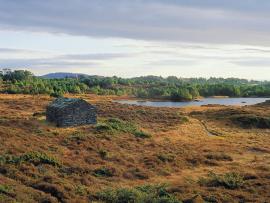Published: 28.10.2004 | Author: Stein Byrkjeland, Nils Georg Brekke
SWAN LAKE
There is no place in Hordaland where there are so many over-wintering song swans as in Tjeldstømarka. And there are few places in the county that have had this birdfowl as a guest for as long.
It is during the winter that the swans give most character to the area. At the most, nearly 80 Song Swans have been seen here at one time. On the sea, the song swans like to graze on the eelgrass, but it is somewhat uncertain which plants the swans on the freshwater Tjeldstømarka eat. Early in the 1980s, a pair built a nest, but the nest was abandoned before any eggs were laid. Freshwater so far out on the coast seldom freezes. When it does, the swans must move. Then, they tend to head for the coast, with the embayment south on Skogsøyna as a much sought-after refuge. Some of the birds fly occasionally also to Lake Skulehusvatnet in Fjell. Large, heavy birds such as these are vulnerable when they fly. Every winter, several swans collide with power lines in Hordaland - also in Øygarden.
In the spring, flocks of Grey Goose often rest in Tjeldstømarka, and in recent years the nesting population has increased substantially. Roughly 10 pairs of goose nested in the area in 2004. Several types of duck make their permanent residence here, and there are wading birds such as the Lapwing, Oystercatcher, Red Shank and Snipe. The easiest to notice is nonetheless the Curlew, with its characteristic flight display. The Curlew is one of our biggest waders, easy to recognize with its long and downward-curving beak and long legs. Six-seven pairs nest in Tjeldstømarka. A number of years ago, the Ruff had its mating arena out on the bog during the spring migrations, but this has unfortunately come to an end. Out toward Hjeltefjord in the east, a pair of Arctic Skua have nested year after year, in fact as the only place in the county in our time.
In the bog one sees many old tree roots, as witness to that the area at one time was covered in forest. Tjeldstømarka is a combined nature preserve and cultural heritage area, and it was protected as a nature reserve in 1995. There are marked trails in the area, and a little hide for observing the birds is set up just on the east side of the highway.
Peat store in the tjeldstø fields
The farm Tjeldstø on Alvøy is first mentioned in 1519, but is much older. It lies facing the Hjeltefjord and has a good harbour. In 1664 there were four farm units at Tjeldstø; two in Garden and two in Høyen, with enclosed fields reaching from the farm down towards the sea. Two hundred years later the number of farms had risen to 14. The enclosed fields then looked like a patchwork quilt, with cornfields and hayfields.
The peat bogs were an important resource for all the farms here on the treeless islands. It was the burnable peat that kept the houses warm, and right up until the 1950s peat was cut in the Tjeldstø fields. By then, most of the peat bogs were empty, and electricity had arrived as a new source of energy.
Right up until the new legislation on land reform in 1900, all the farms in Alvøy cut peat wherever they wanted, in the common outlying fields. Tjeldstø had Storemyri (the large bog) right outside the farmland area. A hundred years later this layer of earth was dug up, and in the 1920s many farmers had problems finding fuel. Every farm had its own sections in the peat bog, and around the bog there is a group of stone houses where the peat was stored before being taken home to the farmyard. Today the peat bog in the area is protected, and the old peat stores – proofs of the old energy supply – are taken good care of.
- Frantzen, E. 1999. Observasjonar i Tjeldstømarka og nærområda. Rapport,Norsk Ornitologisk Forening avd. Hordaland.
- Fylkesmannen i Hordaland 1999. Tjeldstømarka naturreservat. – Ein serie informasjonsplakatar oppsette i naturreservatet.





